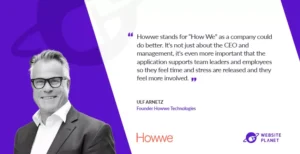Do you sometimes feel that you are fighting fires not just on the operational side of the business, but also on the strategic side? Take a deep breath and stop playing ‘whack-a-mole’ with your company’s future!
When I speak to Board Directors and CEOs I am often left with the impression that they crave to have more time. Indeed, this is also echoed in our findings from the Howwe Growth Assessment™ under the perspective of the “CEO’s environment” and their answers to our question whether the CEO has enough time to actively drive his or her strategy.
The Paradox of CEO Time Management
Assuming each CEO is totally in control of their own time, and has a plethora of people beneath them, not just for operational activities, but also for “Chief of Staff/ Office of the CEO” functions, why is it that CEOs often do not feel in control of their own destinies, or at least have to struggle to get ‘time back’ to complete their days, weeks or months? Having often been in the CEO role myself (of relatively small companies), it’s tongue in cheek when I say that ‘surely the CEOs job should be the easiest role to “get stuff done”’ with all the infrastructure below? The reality is of course far from this assumption. Despite the support structure, CEOs often have to fight to reclaim their time due to a multitude of demands.
I’ll be looking at the Time Management process and techniques in more detail in another article, along with a Leading with Excellence piece, but for now after reading this Harvard Business Review’s article written by Michael E. Porter and Nitin Nohria about where CEOs in particular spend their time I thought it may enliven some discussions on this important subject.
The Demands on a CEO’s Time
- Everyone wants a piece of the CEO. Externally shareholders, analysts, customers of course, partners want their time and the CEO wants to be seen internally – not just with the Exec team – they need to mingle, get to know and associate with lower levels of staff – not just to ‘show’ that they care or to be seen doing the right thing – but importantly to get feedback from staff on issues at lower levels, and how things can be done better. Listening to feedback externally and internally is a vital part of the CEOs job.
- Does the CEO have the perfect culture? We know culture beats strategy, and is always evolving, it doesn’t stand still. Does the CEO have the balances of delegation, visibility, operational vs. strategic, internal vs. external? It is highly unlikely that at any particular time of the day, week, month, quarter that there is a perfect balance in any organization. Does the CEO have the right talent in their ranks, is the team still forming rather than performing, are their underlying political, misconduct, compliance, risk issues that have not been fully addressed?
- There can be so many issues that detract the CEO from their own day, that they – and then of course – the Executive team and then, so on and so forth, layer upon layer, start to play ‘whac-a-mole’ with their diaries and the urgent over the important. As satisfying as it is to be ‘busy’, how much better to be ‘effective’? 36% of CEO’s time is reactive, the HBR authors commented.
Steps to more Effective Leadership
The article I reference was written in 2018. The authors suggest that CEOs can take steps to more effectively manage their time and now platforms such as Howwe exist, I add a Howwe slant to this, because CEOs can be much more effective by leveraging a platform such as Howwe to drive of execution. And, self evidently, if CEOs are more effective in driving strategy, they can give time back not just to themselves but to the entire organization!
- Set (better) Agendas. The more planned the CEO is the better the result. The HBR Authors suggest an “explicit agenda is one of the CEO’s most important tools for making progress on multiple work streams simultaneously, addressing differences in the rate of progress across priorities”. Since the article was written, business-critical platforms and methodologies such as Howwe now give the CEO a unique ability to drive multiple agendas simultaneously, and regularly, in the Acceleration Meeting. This is how (say) a CEO of a Healthcare company could drive separate agendas for improving Patient Care, Innovation, Additional Revenue Streams, Compliance and EBIT, each in their own Weekly 15-30 minute meeting with associated leaders. Everyone updates the platform prior, commitments are taken and everyone leaves a meeting with a full understanding. Perhaps 2 hours a week in total the CEO can handle all important challenges from the ground-up, engaging their teammates in constructive, structured meetings where prior results and future commitments are recorded in a platform. Set the Agenda, but be rigorous and structured in how it is followed up across the entire company.
- Make it Visible. Porter and Nohria suggest that “CEOs can benefit from making their personal agenda explicit to others” i.e. in Howwe speak ‘make it visible’. Technology today enables leaders to share their Vision (Most Important Goals or MIGs), their timelines and their enabling Strategic Initiatives not via email, or excel, or via traditional analogue or Teams townhalls, but in a single, cloud-based digital platform. Clarity of purpose with definitions of ‘done’, enabling progressive leadership teams below and beyond the CEOs direct reach to see where they can help with the MIGs, to connect and collaborate their teams to Key Activities to ‘get stuff done’. CEOs should grasp this technology revolution to better visualize progress-to-plan and empower staff to leverage the entire organization, including all cross-functional teams, and bring the whole organization’s power to drive execution.
- Crisis management. 89% of CEOs spent only 1% of their time on crises. Here, the CEO’s time is not the challenge, it is the speed and effectiveness of response that is important. During COVID-19 as an example, CEOS that used Howwe saw their organizations at the tips of their fingers, and enabled them to reprioritize, reorganize and realign extremely quickly.
- Cleanse the diary. Don’t just do things because prior CEOs did, or that it is simply a habit?. Assess the diary, does your own work contribute to your own Agenda or is it a legacy from the past behaviors?
- Delegate and build. Ensure you have a strong team below you. We know we should do this as early as possible when we inherit or start a new team, and then delegate. Micromanaging is suffocating. Using a platform such as Howwe enables all leaders to become better leaders; leaving the day-to-day to be separated from the strategic. You pay your senior leaders to lead, and so do they down through the organization, and to do a great job for you. Trust them to do it for you. Coach and guide them and ensure they have the resources for their role. Make sure bottlenecks are visible, and use the Howwe Acceleration Meeting at every management team meeting to identify and escalate challenges quickly.
- Stay connected. The CEOs in the HBR study spent “considerable time (32% of their time with internal constituencies, on average) with a broader group of senior leaders, often called the top 100 (plus or minus). Many in this group report to the CEO’s direct reports.” Modern business-critical platforms such as Howwe enable you to stay very connected to your teams, but most importantly of all, to stay very informed. Leaders can then spend time on solutions and growth and not on gathering data; when leaders meet together they can actually work on the future rather than firefighting on the plan.
Harnessing technology to deliver your strategy.
I can’t agree more when the authors say “The CEO’s single most powerful lever is ensuring that every unit—and the company as a whole—has a clear, well-defined strategy. Strategy creates alignment among the many decisions within a business and across the organization….And without clarity on strategy, the CEO will be drawn into too many tactical decisions.” It is incumbent that the CEO understands and harnesses modern technology to drive their strategy. In the same way as any large enterprise CFO would drive their finance operation via a financial application, or any Sales or Manufacturing Director would utilize a CRM or ERP digital platform across their teams; so too must a CEO look to a company-wide strategy execution platform such as Howwe. Their ‘team’ is the entire company! This is the modern way to leverage and mobilize their entire business towards their strategic initiative execution.
I recommend reading this HBR article and reflecting on the Author’s other points such as “designing, monitoring, and improving processes, aligning organizational structure and culture and allowing for accessibility and spontaneity”. These areas and so many areas of a CEOs role can be improved from grasping a platform such as Howwe to help you visualize, drive and stay deeply connected to your strategy and to your teams. By being more focused on the important vs. the urgent, and not playing whac-a-mole with what crops up out of the blue, I hope you will be able to then spend more time on the urgent including time with customers.
It is hard to believe but the research for the HBR article found that ‘most of our CEOs were dismayed to discover how little time they spent with their customers—just 3%, on average. It surprised some even more to learn that this was less than the amount they spent with consultants.’ Where do you as CEO spend your time? Are you playing ‘whac-a-mole’ with the urgent vs. the strategic, and how much time do you spend with your own existing or future customers?
Article by Stephen Bowhill, MD at Howwe ANZ.





